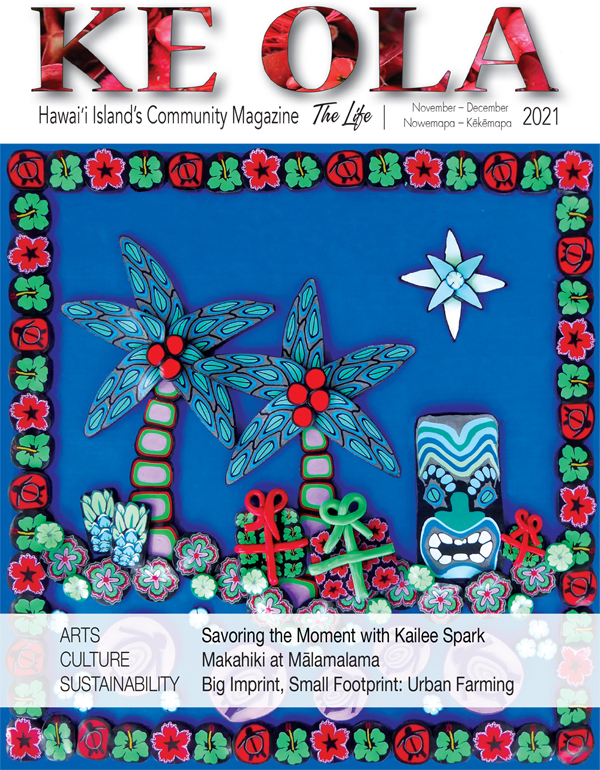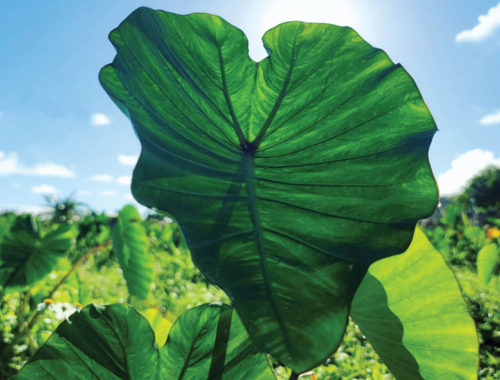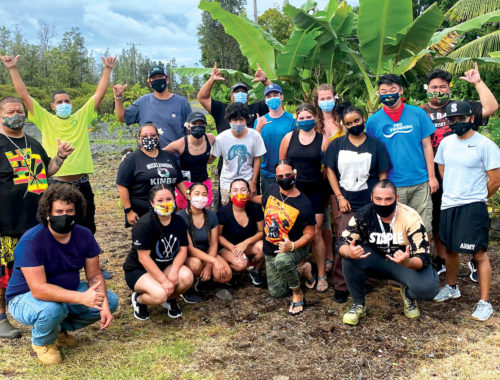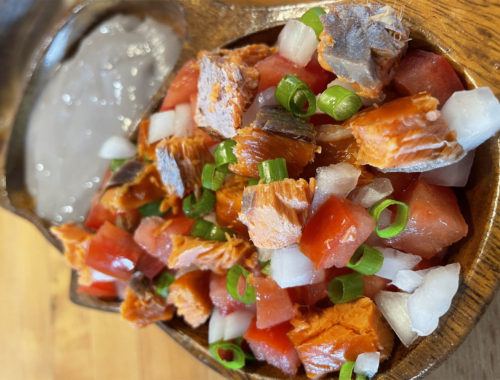
Big Impact, Small Footprint: Urban Farming on Hawai‘i Island

By Brittany P. Anderson
Most people envision Hawai‘i as a place to get away from city life, slow down, and reconnect with the land. But, according to US Census data, almost 92% of Hawai‘i State’s population lives in urban areas. Urban agriculture provides the opportunity to produce fresh local food for communities within a more densely populated area. For Hawai‘i Island residents, country living may be out of reach, but that hasn’t stopped island city dwellers from rolling up their sleeves and getting their hands dirty.
Herbal Therapy
Gardening is an activity so many people find therapeutic. There’s something calming about spending time amongst plants. Yet, it can be a challenge to find gardening space within a city landscape.
Soni Pomaski, co-owner of Moon and Turtle, has a small herb garden carved out within Hilo’s historic downtown. Soni’s plot is tucked behind the restaurant she runs along with her chef husband, Mark.
“There aren’t many little houses in historic downtown, and having a yard is unique,” she says of the home they share behind the restaurant. When the couple moved in, Soni and Mark found a kaffir lime tree already established in the little yard. “The kaffir lime is the first thing I used, and really I just enjoyed hanging out and finding peace and solitude in the garden.” Here Soni quiets her mind and cultivates herbs used in her specialty cocktails and their locally-minded menu.
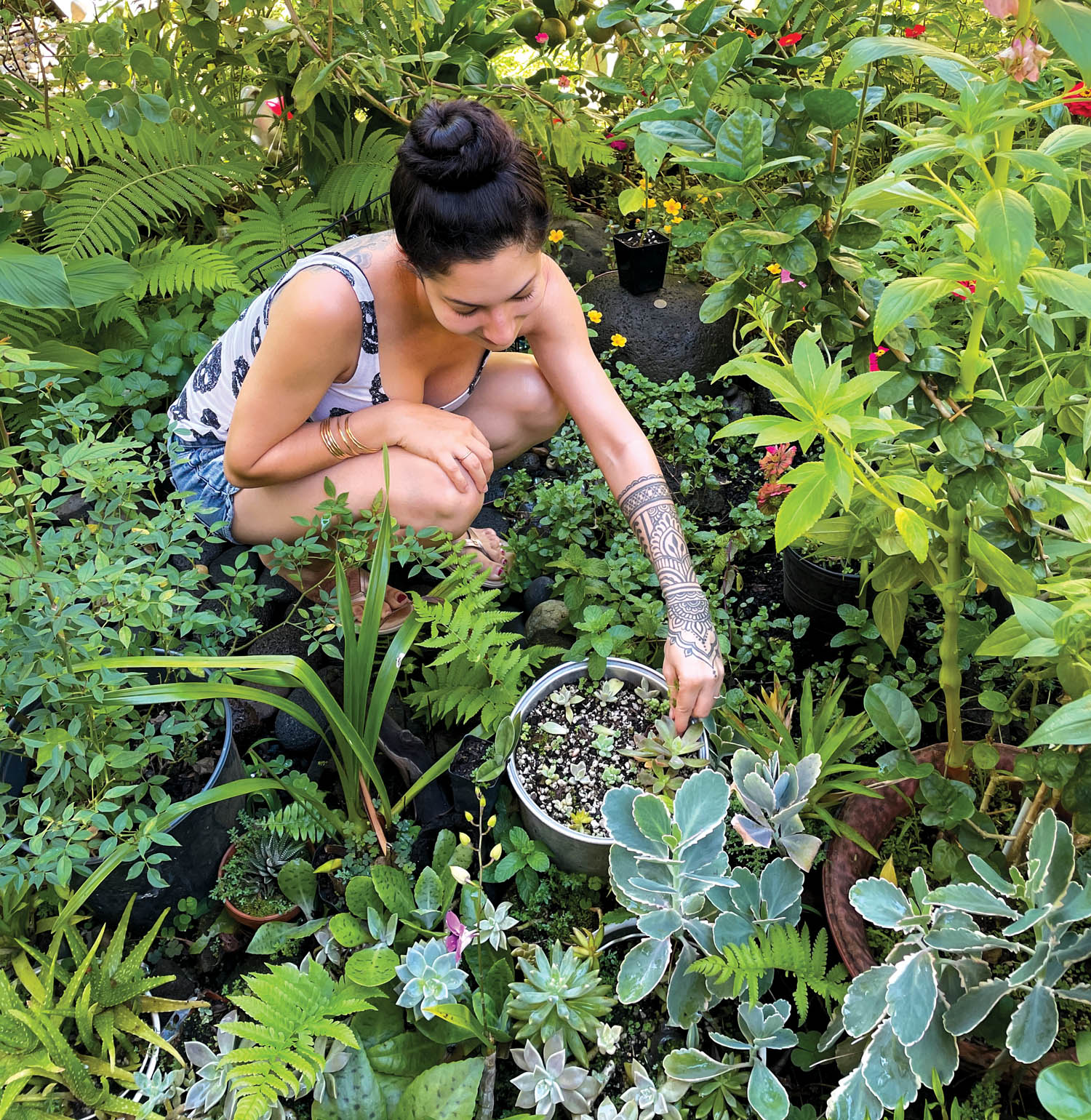
Soni’s first cocktail inspiration came from the kaffir lime, and quickly, she was exploring more herbs that spurred creativity in the kitchen. Then, her mother-in-law gifted Soni a small shiso plant that flourished in the small, yet burgeoning, garden. It did so well, Soni had to find creative ways to use the aromatic herb. This gave birth to her famously good signature cocktail, Shiso Sour. The couple soon had more herbs, producing further inspiration in the kitchen.
“When we opened the restaurant and ended up living here, there was always this natural gravitation to be outside,” Soni says. “I could put things in the ground and watch them grow,” she adds in a peaceful tone.
“I’ve always been someone who loved nature. It’s made me feel really peaceful,” she says. Soni credits her mother for cultivating her connection with nature. From second through eighth grade, Soni attended a Waldorf school in New Jersey. It had 20 acres and a big garden. “That’s where I learned the garden is my happy place,” Soni remarks.
There is a natural regenerative element in gardening that can contribute strongly to our mental health and wellbeing. Increasing research in horticulture therapy shows that gardening is beneficial to psychological and physical health.
“We have a big disconnect with nature,” Soni explains. “So many people are reaching out to nature even if they don’t understand why. We are nature. It all ties into mental health, feeding ourselves physically and mentally,” Soni continues.
Owning and running a restaurant is hard work, but Soni carved out time to be amongst her plants. “Drained and overwhelmed from work, the garden recharged, and gave me peace. Especially during Covid, it has been great to have that space,” she remarks.
Due to the pandemic, the couple’s eatery was shuttered for close to a year; however, they were finally able to reopen in October. Soni maintains positive energy as she surveys the new growth in her plants.
“Even if it’s a small thing—what new leaves have popped up—whatever it is to find a sense of peace with the turmoil that is now,” she says with perennial optimism.
Plant Food
A stone’s throw from the famous La‘aloa (Magic Sands) Beach in Kailua-Kona, amidst compact homes and carefree beachgoers, Paul Pencak tends to his secret permaculture farm. Like so many on Hawai‘i Island’s Kona coast, the community affords little open space in the design, opting for cement driveways and paver patios, instead. Yet, with a goal of food independence and self-sufficiency, Paul is turning his standard Kailua-Kona property into a food forest.
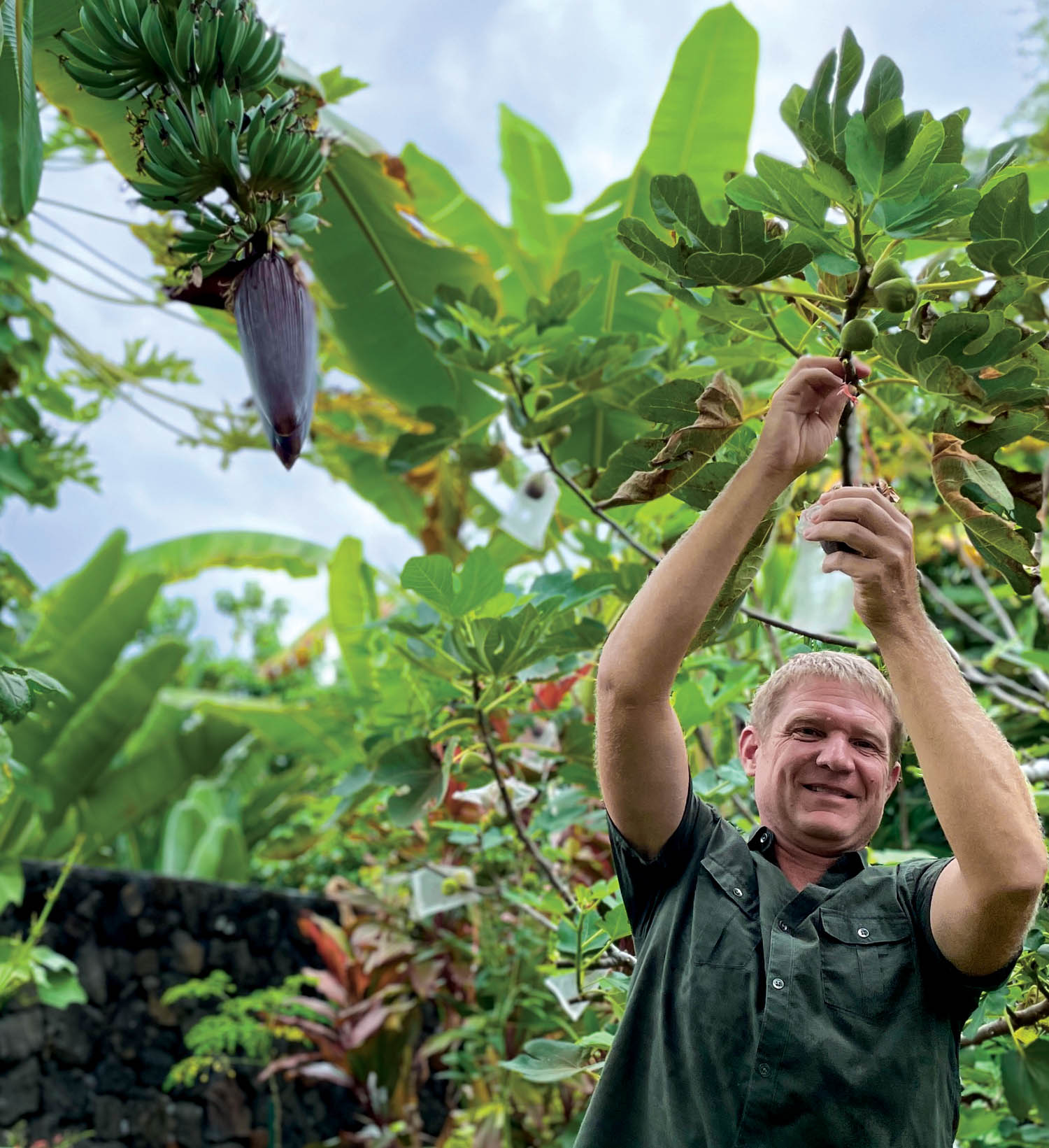
“My goal is to plant food, as much as possible,” Paul says. “I’ve always been a gardener, it’s just now snowballed into a bit more,” he adds with a chuckle. Entering into Paul’s courtyard gives a hint of what’s to come. The tall fence that surrounds the property is obscured by flowering vines with edible and decorative plants popping out in unexpected places.
“Everyone said I was going to have to break up the cement driveway, but you don’t need that much soil space if you can go up,” he remarks while standing on the concrete.
Paul planted vertically minded tomatoes and passion fruit (liliko‘i) in the sliver of space between the driveway and fence. Two compost bins brimming with nutrient-rich soil occupy a small area on the drive. Creating soil with table scraps and green waste adds to Paul’s self-sufficiency.

The meandering pathway to the backyard is dotted with pots planted with tomatoes, herbs, and a repurposed fountain turned into a planter. In an outdoor sitting area, he lifts up a tray of sprouted microgreens. “These only take two days to sprout in darkness and then they’re ready for the sun. Microgreens are easy and they’re nutrient dense,” he mentions before heading towards the backyard.
“I prefer to be as self-sufficient as possible,” Paul continues, “It doesn’t take much to cut off our supply chain.” It is estimated that 90% of Hawai‘i Island’s food is imported. During the pandemic, residents saw a disruption of supply lines. With the future so uncertain, food independence is at the forefront of many minds. “It’s not like we can’t grow our own food; Hawai‘i Island was able to do it before. We can do it again,” he says with conviction.
“I grow what I like to eat,” Paul states as he plucks juicy figs from one of his trees. Paul has created several zones in the back, maximizing every square inch available. Repurposed metal roofing turned into raised beds has a base of yard clippings that build soil and offer yet another growing space.
“I really enjoy it; the whole process of planting something, watching it grow, and eating it. Fresh things that are picked off the vine just taste better,” Paul comments.
Growing Family
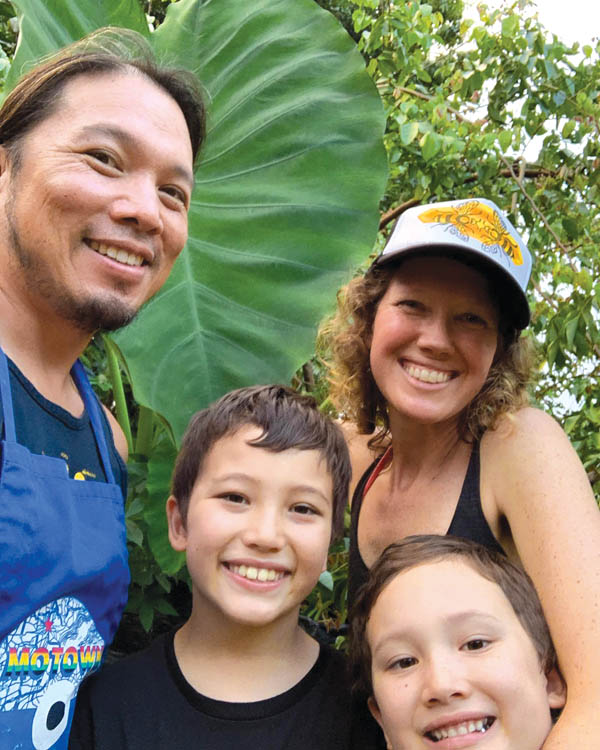
The urban agriculture movement is taking off, especially as Hawai‘i Island residents spend more time in the home. Growing as much food as possible around their house for the Floro family means instilling a sense of responsibility and teaching their children where their food comes from.
At the end of a Hilo cul-de-sac stands an oversized ‘ulu (breadfruit) tree welcoming all who visit the Floros. Rod, Adrean, and their sons Tuwa, 9, and Remi, 7, grow a variety of fruits and vegetables in addition to their laying hens and rabbits on their 0.28-acre lot.
“When I bought the house in 2004, it was just grass and gravel,” Rod says. “I envisioned a food forest and having more of an orchard. I wanted to feed my future family from the land,” he remarks. Rod was inspired by the saying, “The best time to plant a tree is 10 years ago and the next best time is today.” So he did just that, planting the ‘ulu tree and other food-bearing trees around the perimeter of the property. Today, his sons play in their fort built around that same ‘ulu tree he so prophetically planted. “I knew when I had a family, I wanted the ability to feed them from the land,” Rod adds.
The couple laughs when remembering the early years in their home. Adrean always wanted to have chickens, so they started small with a chicken tractor. Chicken tractors are moveable enclosures that allow chickens to eat grass in a specific area and is then moved around a yard or pasture. “When we had the boys we harvested our first round of chickens. Even my mom helped,” Adrean adds. The pair focused on learning how to raise their boys, “When the boys got older, we got chickens again,” she says with a smile.
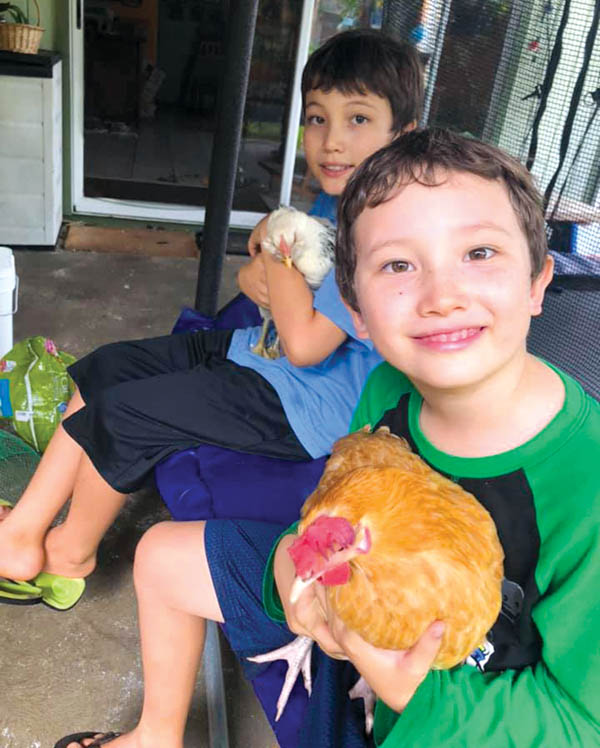
Tuwa and Remi have their own raised garden beds, “We want the boys to know that what you get out is what you put into it,” Rod remarks. Tuwa and Remi eagerly talk about their responsibilities tending to the chickens and rabbits. The boys switch off duties, “Whoever does the chickens, doesn’t do the rabbits,” the bright-eyed Tuwa says. “I like to hold the chickens. I give them treats because I like treats,” Remi adds.
The newest addition to the backyard menagerie is their rabbits. Kept in hutches off the ground, the boys collect greens each day for their bunnies as part of their chores. Chickens dart around the enclosed coop area, pecking at bugs and scratching the ground under the rabbit hutches. Tuwa and Remi gently remove two of their favorite kits (as baby rabbits are called) to snuggle the adorable furry friends in a moment of beautiful tenderness. The boys kindly tuck the kits back in with their mother rabbits, then run to their tree fort to play.
In addition to learning how to take care of plants and animals, Tuwa and Remi learn compassion, treating the animals how they would be like to be treated. “When we have more eggs than we need, we sell them,” the boys enthusiastically note.
“We also share ‘ulu when we have a lot,” Adrean says, “It’s great because in sharing we meet people and make connections.”
Rod and Adrean both think it is important to share their love of local food with their sons. “We try to always eat as locally as we can, either from what we’re growing or what else is grown locally,” Adrean says. “It is important they know where their food comes from, and appreciate how hard it can be to grow it.”
“Really it’s a team effort,” Adrean starts, “We couldn’t accomplish it all without everyone working together,” Rod finishes, as the family beams.
Gardening can be an essential part of keeping our bodies healthy, both physically and mentally, which is especially important during a pandemic. From Soni’s inspiring herbs to Paul’s self-sufficiency and the Floro family wanting to bring their sons up knowing where their food comes from—Hawai‘i Island’s urban dwellers prove they can make a big impact with a small footprint. ❖

Get Growing
For those looking to add a little garden therapy to their life and/or be more self-sufficient, our urban farmers offered some tips to make it happen.
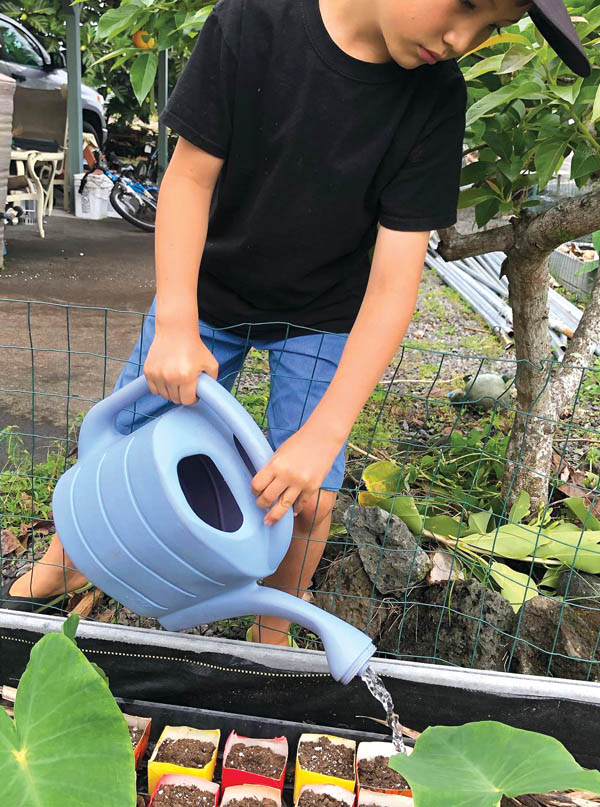
- Start small. Try just one plant and see if it brings you joy. Don’t feel the pressure of starting a whole garden.
- Plant something you like to eat, like herbs you cook with. Once you get the hang of it, plant some more.
- Adjust to your growing conditions. Pots and containers work well in windowsills or patios.
- Some plants don’t need a lot of light, others like full sun. Finding out what works for you can be trial and error—that’s okay! A failure is just a composting opportunity.
- Spend some time with your plants. Check out their leaves, notice new growth, and breathe deeply. Look at what you’ve accomplished!
- Build soil with a small worm bin and compost. City lots often have really bad soil, and making your own compost is a great way to make healthy soil with your kitchen scraps.
- Get connected. Talk to people in your neighborhood, see what they’re growing and share what you can.
